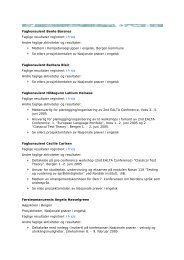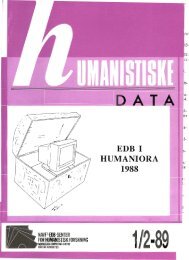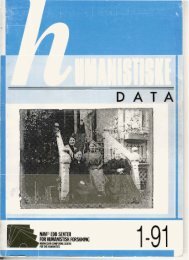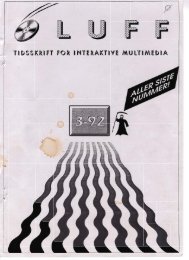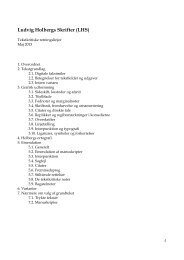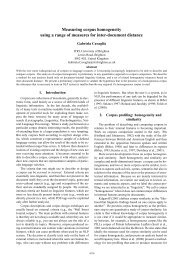1991:2 - Universitetet i Bergen
1991:2 - Universitetet i Bergen
1991:2 - Universitetet i Bergen
Create successful ePaper yourself
Turn your PDF publications into a flip-book with our unique Google optimized e-Paper software.
two decades. It was not until the mival of wordpmcessing in the early<br />
1980's that computing became rnilch mote widespread. Wordprocessing<br />
is a good way of getting peoplc interested in computing, but it is not<br />
specific to the humanities and it is not appropriate to discuss it much<br />
further here.<br />
A similar point can also be made about electronic rnaif. It facilitates<br />
the reservch process in that it enables rapid correspondence, or the<br />
circulation of information to groups of pcopIe, as well as collaborative<br />
writing. Bulletin boards and electronic discussion groups have flourishcd<br />
recently ad it Is not diificult to spend al1 day reading thern. The buIletin<br />
board approach where the user has to Iog on to it ta look for infomation<br />
is better for information which wiEl nor change for some time. but not<br />
so good for quick quesrions and answers. It requires the information<br />
to be well-organized, as well as an casy way of getting printoul or<br />
maiiing information to recipient, and frequent updating. The discussion<br />
groups approach such as BITNET 'lists'. ar digesrs such as HUMANIST,<br />
ANSAX-L, IOUDAIOS, PHILOS-L etc, which use electronic mai1 LO<br />
distribute to al1 rnembers of Uie group, are bctter for quick questions,<br />
the rapid dissemination of information, and discussion of itcms.<br />
Wordprocessing and electronic mil, the information technology ap-<br />
plicarians sharcd by all disclplines. facilitate things which are mcillary<br />
to scholarship. Here I wanl to concentsale on the use of informaiion<br />
technology as a tml in the humanities both for recearch and, ta a<br />
lesser extent. in teaching. This irnposes an intellectual rigour, which<br />
can be alien to the humanities scholar's way of working. However ir<br />
forces thc schofar to think out more clearly the objectivcs of the<br />
research and how to achievc hose objec~ives. It aIso forcos the scholar<br />
to make decisions which in more traditional ways of warking would<br />
be put off to much nearer the end of the project. If they are the right<br />
decisions, the project will proceed reasonably wcll. If thcy are ~he<br />
wmng ones, it can take a long drne to put them right.<br />
3. TEXT-BASED APPLICATIONS<br />
In the area of text-based subjects, miditionai applications were based<br />
on concordances and text retrievai. In this case the basic source material<br />
is the text itself and fewer decisions arc requircd on what to put into<br />
the computer. Decisions may need to be made on choosing an cdition,<br />
sampling the text and encoding the text, but the basic rnatcrial is fairly<br />
clear at the start. The method of storing the text initially is also fairly<br />
clcar. It musL be input as a sequential text file.<br />
Concordances and text relrieval applieations can be used to advantage<br />
for stylistic analyscs, critical edi tions, and lexical studies. but they look




